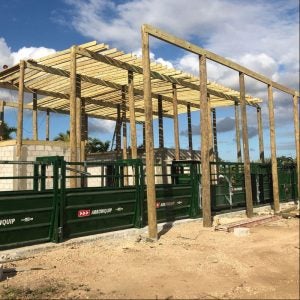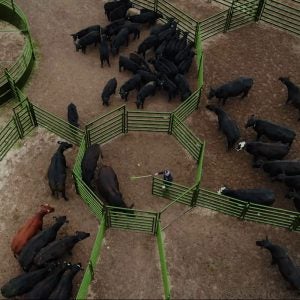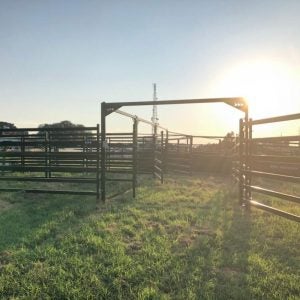Creating a new cattle handling system can be stressful. From panels and gates to cattle tubs, adjustable alleys, and squeeze chutes, the options available to ranchers are endless. When there are so many options available to you, choosing the right pieces can prove challenging and it can be difficult to narrow down the right components, let alone nail down your design.
That design may be the most important piece of the puzzle though, especially when you consider that it is the map that your cattle must follow when you are working them. Creating a logical flow that works with cattle behavior rather than against it is the key to making your handling system as low-stress and efficient as it can be.
If you are in the process of building a new cattle handling system, or have plans to change yours up soon, these are our top tips to make the process as easy as possible:

Getting started
Do your research.
- Take some time to look at cattle handling system designs.
- There are more options out there than you think, and once you start looking at different designs you may find inspiration that will take you in a new direction.
- There is new research coming out regularly surrounding low stress cattle handling and best practices to manage your cattle, so taking time to research the latest findings before you get started is a good idea.
- Check out this video for some preliminary ideas!
Determine the right location on your property.
- Ask these questions before you start.
- The answers can easily determine what location will work best for you, so asking them early in the process is helpful.
- Are you working with pre-existing structures or buildings?
- Do you have plans to put a shelter over your working system?
- Is there a section of land you have dedicated to this task, or are you open to using a different area that might be better suited to a handling system?
- Try to find a location that is flat for your working equipment. Uneven ground can cause doors to close improperly, or difficulty moving portable cattle handling equipment.
- Consider pouring a concrete pad for your cattle chute.
- If you are setting up a stationary handling system, bolting your chute to a concrete pad can provide extra security.
- Or if you are working with uneven ground, a concrete pad beneath your cattle chute and key handling components provides a flat surface that will ensure everything works properly.
- Think about where your cattle are located, and how you will get them to the handling system.
- While this may sound obvious, taking a moment to think through the logistics is an essential step in the process.
- If you have cattle that are spread over a wide area, a stationary handling system may not be the right option for your needs unless you are willing to move them to your system every time they need to be processed. In this case, a portable handling system may be the best option for your needs.

Finding the components
Cattle Squeeze Chute
- A squeeze chute isn’t just a squeeze chute. This is a key element of your handling system that can make or break the process of handling your cattle. Negative experiences in the chute can lead to a lifetime of handling challenges, so choose wisely!
- Ask your veterinarian for recommendations, as they will have some suggestions based on the type of operation you are running and your needs.
- Go visit your local cattle chute dealer and try them out! Getting your hands on the equipment is the best way to determine if it is the right one for you.
Alleys, Tubs, and Other Components
- Do you need a loading ramp and a tub that can provide continuous flow for loading? What about alleys that can narrow down to keep even the smallest calves from turning around? The age of cattle you handle and tasks you need to complete will help determine the components you need.
- Have you ever heard of a draft pound? This key component serves as the connection piece for all elements of your handling system, and allows you to bring a cow back into the chute easily if you happen to miss a catch. It also makes sorting your livestock a breeze!
- You have a list of the tasks you need your handling system to do, so this is where you find the options you need to fulfil those tasks and make your life easy.
Panels and Gates
- There is a misconception in the industry that all panels are made equal, but that is not the case. Panels made with round pipes are proven to cause excess bruising because of the small contact point, resulting in dark cutters and lower prices at sale time.
- The best panels are made with wide oval or rectangular rails that provide a larger contact point for cattle to run up against. The wider contact point spreads out the pressure of the contact, resulting in less bruising and damage. They also provide a significant visual barrier to minimize the likelihood of cattle challenging the fence.

Bonus tips to make your life easier
- Work with the experts.
- The Arrowquip team offers a free Consulting Service on cattle handling systems. Their team of experts will work with you every step of the way to take you from initial thoughts to final construction, to ensure your handling system is exactly what you need it to be.
- Consider making updates in phases, rather than an all-in-one project.
- If the idea of taking on the whole project at once is overwhelming, or it just isn’t in the budget, consider making updates in phases. Start by upgrading your squeeze chute or adding a draft pound to your handling system, then branching out to add on new pieces as time and budget allows.
- Look at the warranty.
- Your cattle handling system is an investment that needs to last for years to come. Look at the warranty that is backing the equipment and ensure you are satisfied with it, as well as the customer service the company provides. When you are investing significant time and money in a new system, you want to be sure you are getting quality and value that reflects your investment.
When it comes to creating a new cattle handling system, there is no room for compromise. Taking the time to do your research, determine the right location, find the right components, and using our tips to make your life easier will make the process as easy as possible, while ensuring you get the job done right. If you are ready to start the process of designing your new custom cattle handling system, Arrowquip’s team of experts are here to assist you. Contact them today for details.
This article was published on behalf of Arrowquip.


